Factors Influencing Online Financial Services Usage in Malaysia
VerifiedAdded on 2022/11/25
|22
|6472
|340
Report
AI Summary
This report delves into the factors influencing consumers' intention to use online financial services in Malaysia. It begins with an introduction outlining the research problem, aim, objectives, and significance, emphasizing the shift in banking due to technological advancements and the need to understand consumer behavior. The literature review explores the dependent variable (consumers' intention) and various independent variables like security, advertising, marketing promotions, and the Technology Acceptance Model (TAM). The research methodology section details the design, data collection methods (surveys), and sampling process. The study aims to identify the most impactful factors affecting consumer adoption to increase transaction volumes, brand reputation, and minimize public relations efforts and brand switching. The report also covers expected outcomes and provides a comprehensive list of references, offering valuable insights for banking sectors and researchers seeking to understand online financial services adoption.
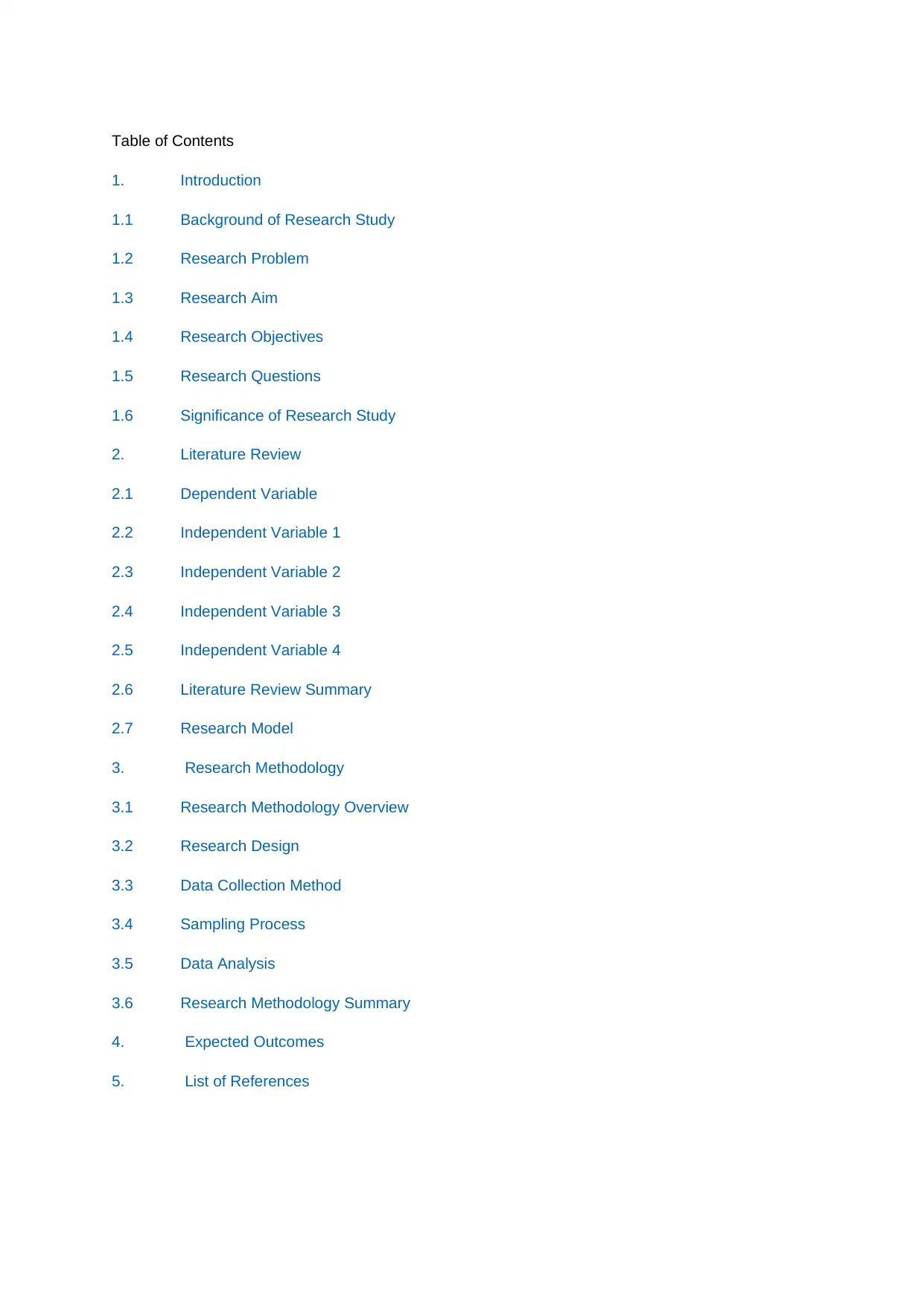
Table of Contents
1. Introduction
1.1 Background of Research Study
1.2 Research Problem
1.3 Research Aim
1.4 Research Objectives
1.5 Research Questions
1.6 Significance of Research Study
2. Literature Review
2.1 Dependent Variable
2.2 Independent Variable 1
2.3 Independent Variable 2
2.4 Independent Variable 3
2.5 Independent Variable 4
2.6 Literature Review Summary
2.7 Research Model
3. Research Methodology
3.1 Research Methodology Overview
3.2 Research Design
3.3 Data Collection Method
3.4 Sampling Process
3.5 Data Analysis
3.6 Research Methodology Summary
4. Expected Outcomes
5. List of References
1. Introduction
1.1 Background of Research Study
1.2 Research Problem
1.3 Research Aim
1.4 Research Objectives
1.5 Research Questions
1.6 Significance of Research Study
2. Literature Review
2.1 Dependent Variable
2.2 Independent Variable 1
2.3 Independent Variable 2
2.4 Independent Variable 3
2.5 Independent Variable 4
2.6 Literature Review Summary
2.7 Research Model
3. Research Methodology
3.1 Research Methodology Overview
3.2 Research Design
3.3 Data Collection Method
3.4 Sampling Process
3.5 Data Analysis
3.6 Research Methodology Summary
4. Expected Outcomes
5. List of References
Paraphrase This Document
Need a fresh take? Get an instant paraphrase of this document with our AI Paraphraser

1. Introduction
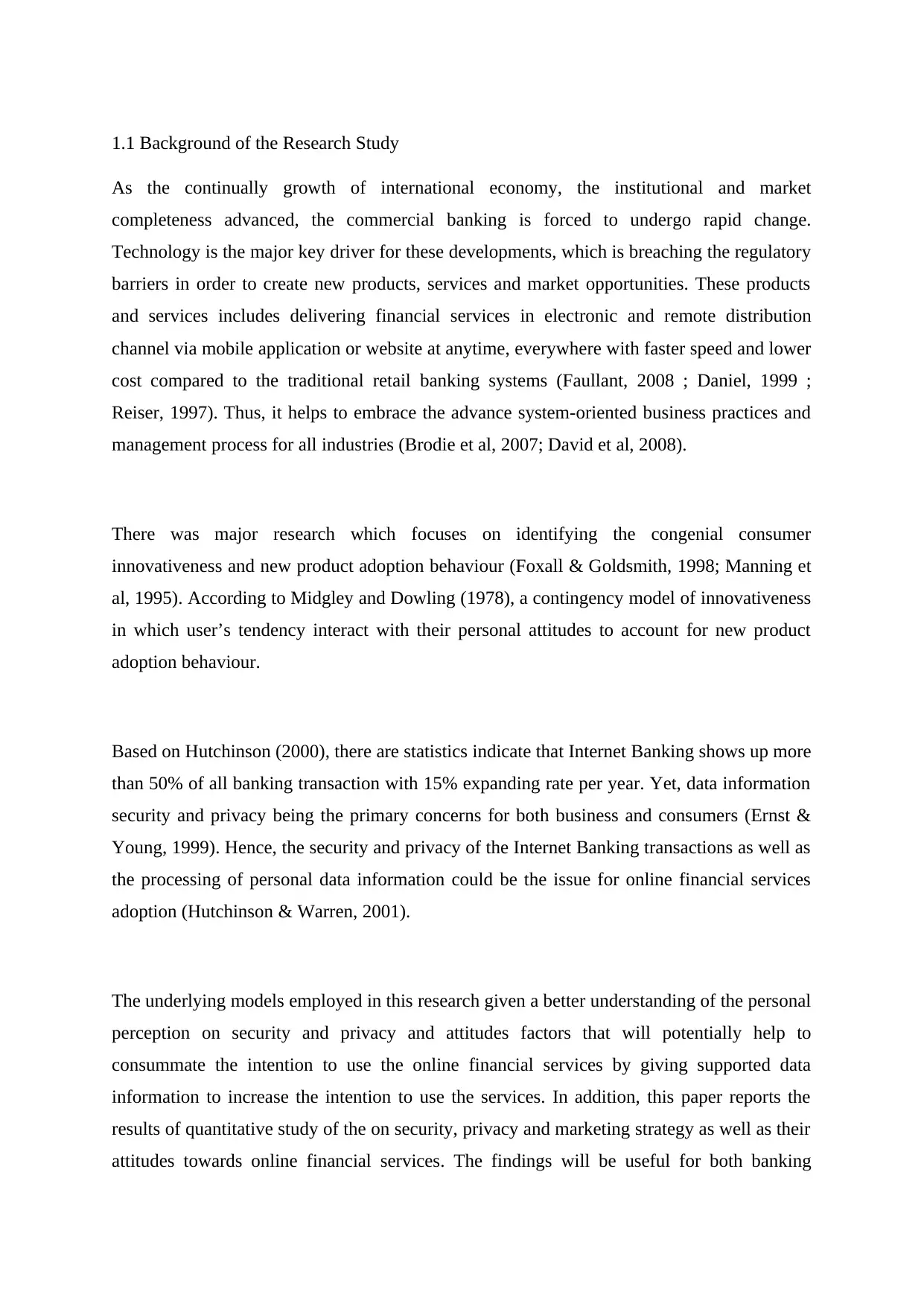
1.1 Background of the Research Study
As the continually growth of international economy, the institutional and market
completeness advanced, the commercial banking is forced to undergo rapid change.
Technology is the major key driver for these developments, which is breaching the regulatory
barriers in order to create new products, services and market opportunities. These products
and services includes delivering financial services in electronic and remote distribution
channel via mobile application or website at anytime, everywhere with faster speed and lower
cost compared to the traditional retail banking systems (Faullant, 2008 ; Daniel, 1999 ;
Reiser, 1997). Thus, it helps to embrace the advance system-oriented business practices and
management process for all industries (Brodie et al, 2007; David et al, 2008).
There was major research which focuses on identifying the congenial consumer
innovativeness and new product adoption behaviour (Foxall & Goldsmith, 1998; Manning et
al, 1995). According to Midgley and Dowling (1978), a contingency model of innovativeness
in which user’s tendency interact with their personal attitudes to account for new product
adoption behaviour.
Based on Hutchinson (2000), there are statistics indicate that Internet Banking shows up more
than 50% of all banking transaction with 15% expanding rate per year. Yet, data information
security and privacy being the primary concerns for both business and consumers (Ernst &
Young, 1999). Hence, the security and privacy of the Internet Banking transactions as well as
the processing of personal data information could be the issue for online financial services
adoption (Hutchinson & Warren, 2001).
The underlying models employed in this research given a better understanding of the personal
perception on security and privacy and attitudes factors that will potentially help to
consummate the intention to use the online financial services by giving supported data
information to increase the intention to use the services. In addition, this paper reports the
results of quantitative study of the on security, privacy and marketing strategy as well as their
attitudes towards online financial services. The findings will be useful for both banking
As the continually growth of international economy, the institutional and market
completeness advanced, the commercial banking is forced to undergo rapid change.
Technology is the major key driver for these developments, which is breaching the regulatory
barriers in order to create new products, services and market opportunities. These products
and services includes delivering financial services in electronic and remote distribution
channel via mobile application or website at anytime, everywhere with faster speed and lower
cost compared to the traditional retail banking systems (Faullant, 2008 ; Daniel, 1999 ;
Reiser, 1997). Thus, it helps to embrace the advance system-oriented business practices and
management process for all industries (Brodie et al, 2007; David et al, 2008).
There was major research which focuses on identifying the congenial consumer
innovativeness and new product adoption behaviour (Foxall & Goldsmith, 1998; Manning et
al, 1995). According to Midgley and Dowling (1978), a contingency model of innovativeness
in which user’s tendency interact with their personal attitudes to account for new product
adoption behaviour.
Based on Hutchinson (2000), there are statistics indicate that Internet Banking shows up more
than 50% of all banking transaction with 15% expanding rate per year. Yet, data information
security and privacy being the primary concerns for both business and consumers (Ernst &
Young, 1999). Hence, the security and privacy of the Internet Banking transactions as well as
the processing of personal data information could be the issue for online financial services
adoption (Hutchinson & Warren, 2001).
The underlying models employed in this research given a better understanding of the personal
perception on security and privacy and attitudes factors that will potentially help to
consummate the intention to use the online financial services by giving supported data
information to increase the intention to use the services. In addition, this paper reports the
results of quantitative study of the on security, privacy and marketing strategy as well as their
attitudes towards online financial services. The findings will be useful for both banking
⊘ This is a preview!⊘
Do you want full access?
Subscribe today to unlock all pages.

Trusted by 1+ million students worldwide
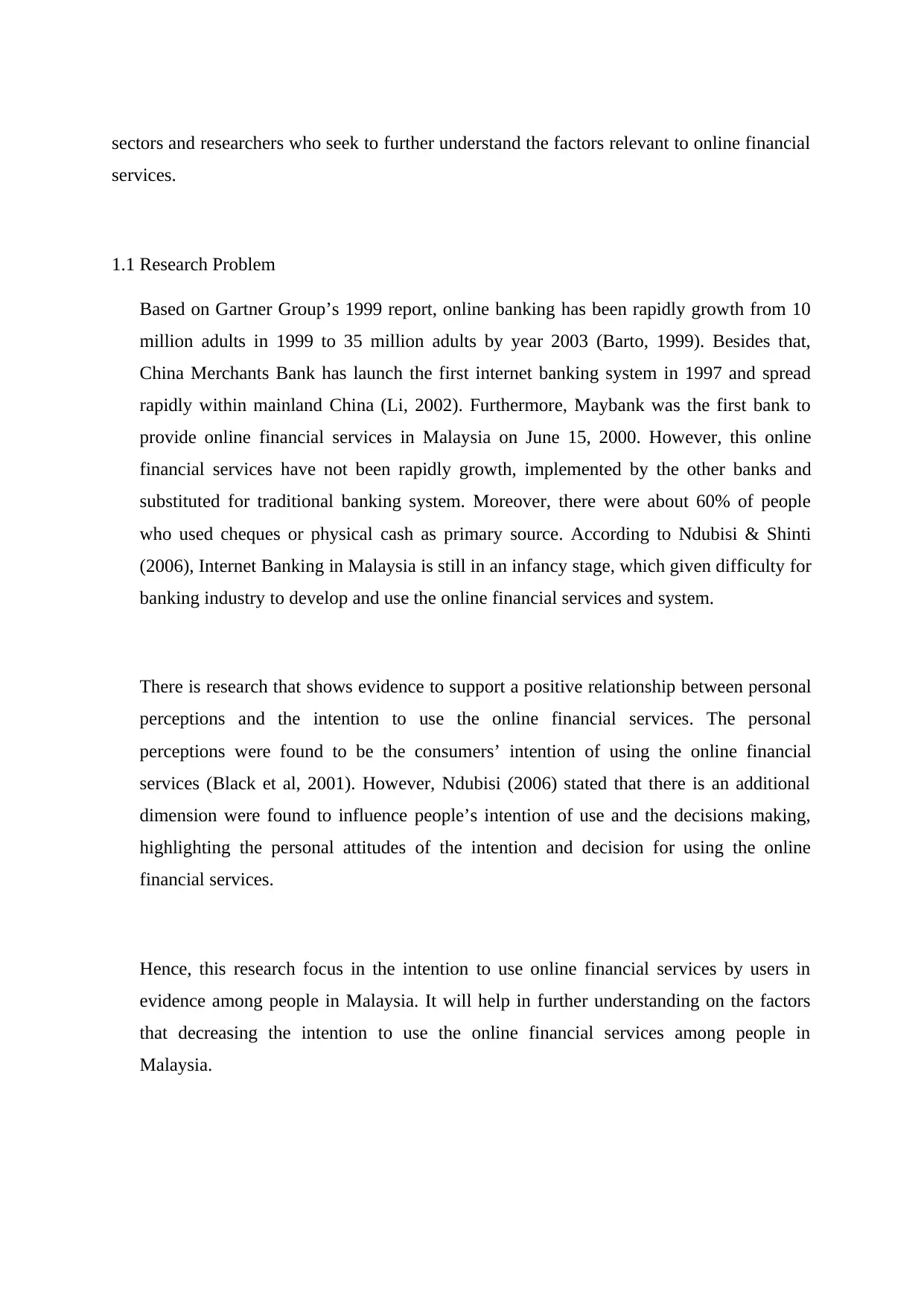
sectors and researchers who seek to further understand the factors relevant to online financial
services.
1.1 Research Problem
Based on Gartner Group’s 1999 report, online banking has been rapidly growth from 10
million adults in 1999 to 35 million adults by year 2003 (Barto, 1999). Besides that,
China Merchants Bank has launch the first internet banking system in 1997 and spread
rapidly within mainland China (Li, 2002). Furthermore, Maybank was the first bank to
provide online financial services in Malaysia on June 15, 2000. However, this online
financial services have not been rapidly growth, implemented by the other banks and
substituted for traditional banking system. Moreover, there were about 60% of people
who used cheques or physical cash as primary source. According to Ndubisi & Shinti
(2006), Internet Banking in Malaysia is still in an infancy stage, which given difficulty for
banking industry to develop and use the online financial services and system.
There is research that shows evidence to support a positive relationship between personal
perceptions and the intention to use the online financial services. The personal
perceptions were found to be the consumers’ intention of using the online financial
services (Black et al, 2001). However, Ndubisi (2006) stated that there is an additional
dimension were found to influence people’s intention of use and the decisions making,
highlighting the personal attitudes of the intention and decision for using the online
financial services.
Hence, this research focus in the intention to use online financial services by users in
evidence among people in Malaysia. It will help in further understanding on the factors
that decreasing the intention to use the online financial services among people in
Malaysia.
services.
1.1 Research Problem
Based on Gartner Group’s 1999 report, online banking has been rapidly growth from 10
million adults in 1999 to 35 million adults by year 2003 (Barto, 1999). Besides that,
China Merchants Bank has launch the first internet banking system in 1997 and spread
rapidly within mainland China (Li, 2002). Furthermore, Maybank was the first bank to
provide online financial services in Malaysia on June 15, 2000. However, this online
financial services have not been rapidly growth, implemented by the other banks and
substituted for traditional banking system. Moreover, there were about 60% of people
who used cheques or physical cash as primary source. According to Ndubisi & Shinti
(2006), Internet Banking in Malaysia is still in an infancy stage, which given difficulty for
banking industry to develop and use the online financial services and system.
There is research that shows evidence to support a positive relationship between personal
perceptions and the intention to use the online financial services. The personal
perceptions were found to be the consumers’ intention of using the online financial
services (Black et al, 2001). However, Ndubisi (2006) stated that there is an additional
dimension were found to influence people’s intention of use and the decisions making,
highlighting the personal attitudes of the intention and decision for using the online
financial services.
Hence, this research focus in the intention to use online financial services by users in
evidence among people in Malaysia. It will help in further understanding on the factors
that decreasing the intention to use the online financial services among people in
Malaysia.
Paraphrase This Document
Need a fresh take? Get an instant paraphrase of this document with our AI Paraphraser
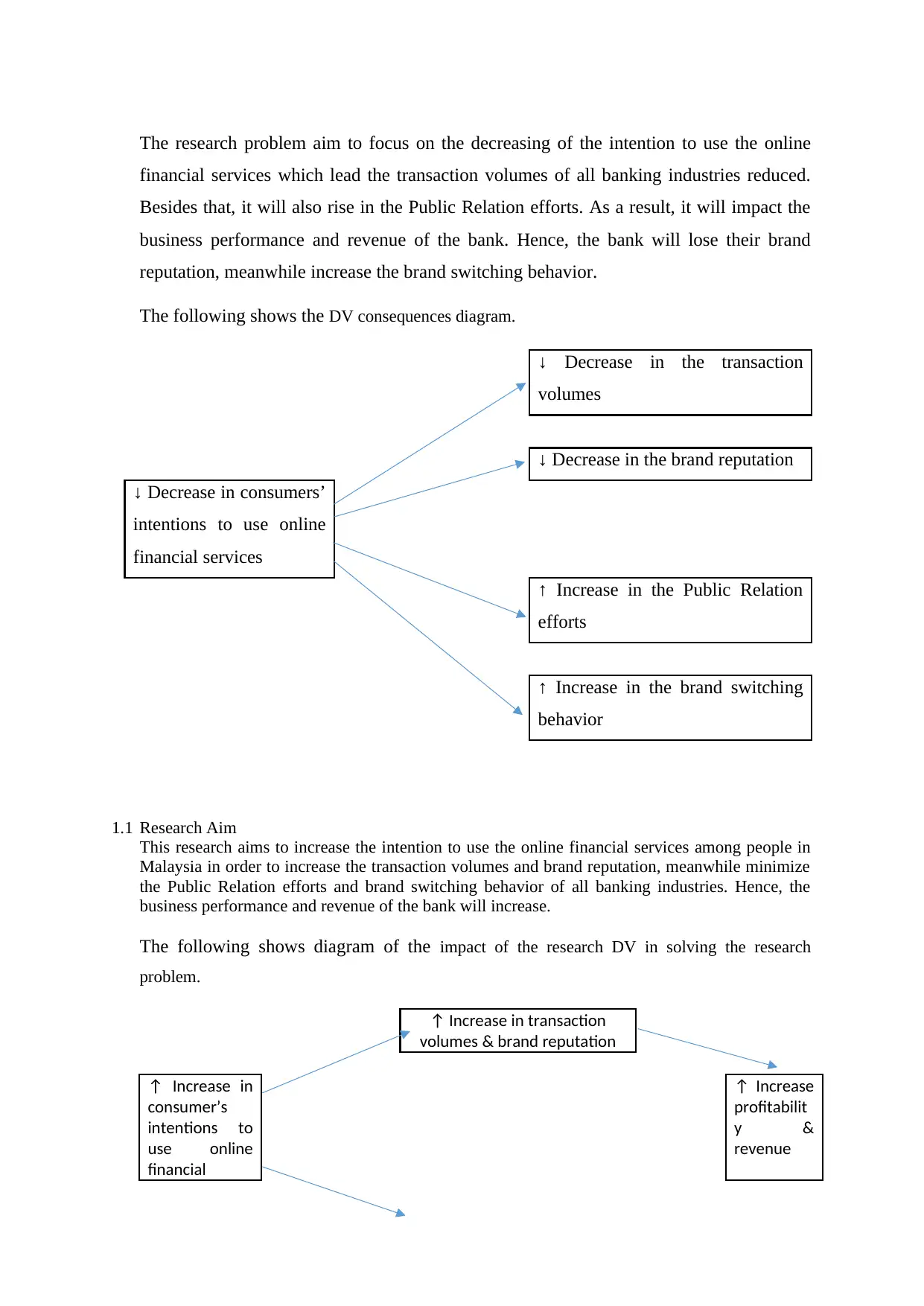
The research problem aim to focus on the decreasing of the intention to use the online
financial services which lead the transaction volumes of all banking industries reduced.
Besides that, it will also rise in the Public Relation efforts. As a result, it will impact the
business performance and revenue of the bank. Hence, the bank will lose their brand
reputation, meanwhile increase the brand switching behavior.
The following shows the DV consequences diagram.
↓ Decrease in the transaction
volumes
↓ Decrease in the brand reputation
↓ Decrease in consumers’
intentions to use online
financial services
↑ Increase in the Public Relation
efforts
↑ Increase in the brand switching
behavior
1.1 Research Aim
This research aims to increase the intention to use the online financial services among people in
Malaysia in order to increase the transaction volumes and brand reputation, meanwhile minimize
the Public Relation efforts and brand switching behavior of all banking industries. Hence, the
business performance and revenue of the bank will increase.
The following shows diagram of the impact of the research DV in solving the research
problem.
↑ Increase in transaction
volumes & brand reputation
↑ Increase in
consumer’s
intentions to
use online
financial
↑ Increase
profitabilit
y &
revenue
financial services which lead the transaction volumes of all banking industries reduced.
Besides that, it will also rise in the Public Relation efforts. As a result, it will impact the
business performance and revenue of the bank. Hence, the bank will lose their brand
reputation, meanwhile increase the brand switching behavior.
The following shows the DV consequences diagram.
↓ Decrease in the transaction
volumes
↓ Decrease in the brand reputation
↓ Decrease in consumers’
intentions to use online
financial services
↑ Increase in the Public Relation
efforts
↑ Increase in the brand switching
behavior
1.1 Research Aim
This research aims to increase the intention to use the online financial services among people in
Malaysia in order to increase the transaction volumes and brand reputation, meanwhile minimize
the Public Relation efforts and brand switching behavior of all banking industries. Hence, the
business performance and revenue of the bank will increase.
The following shows diagram of the impact of the research DV in solving the research
problem.
↑ Increase in transaction
volumes & brand reputation
↑ Increase in
consumer’s
intentions to
use online
financial
↑ Increase
profitabilit
y &
revenue
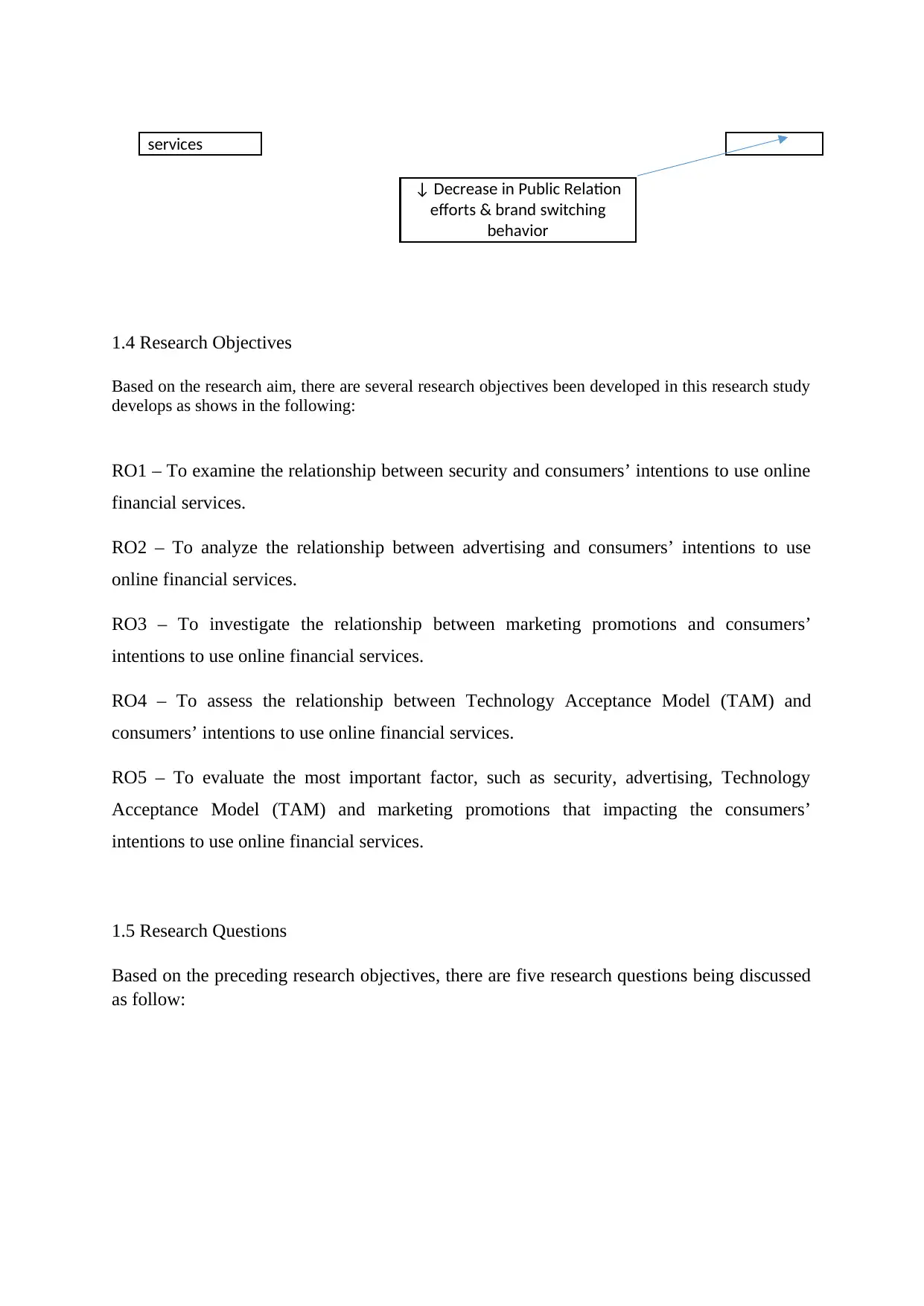
services
↓ Decrease in Public Relation
efforts & brand switching
behavior
1.4 Research Objectives
Based on the research aim, there are several research objectives been developed in this research study
develops as shows in the following:
RO1 – To examine the relationship between security and consumers’ intentions to use online
financial services.
RO2 – To analyze the relationship between advertising and consumers’ intentions to use
online financial services.
RO3 – To investigate the relationship between marketing promotions and consumers’
intentions to use online financial services.
RO4 – To assess the relationship between Technology Acceptance Model (TAM) and
consumers’ intentions to use online financial services.
RO5 – To evaluate the most important factor, such as security, advertising, Technology
Acceptance Model (TAM) and marketing promotions that impacting the consumers’
intentions to use online financial services.
1.5 Research Questions
Based on the preceding research objectives, there are five research questions being discussed
as follow:
↓ Decrease in Public Relation
efforts & brand switching
behavior
1.4 Research Objectives
Based on the research aim, there are several research objectives been developed in this research study
develops as shows in the following:
RO1 – To examine the relationship between security and consumers’ intentions to use online
financial services.
RO2 – To analyze the relationship between advertising and consumers’ intentions to use
online financial services.
RO3 – To investigate the relationship between marketing promotions and consumers’
intentions to use online financial services.
RO4 – To assess the relationship between Technology Acceptance Model (TAM) and
consumers’ intentions to use online financial services.
RO5 – To evaluate the most important factor, such as security, advertising, Technology
Acceptance Model (TAM) and marketing promotions that impacting the consumers’
intentions to use online financial services.
1.5 Research Questions
Based on the preceding research objectives, there are five research questions being discussed
as follow:
⊘ This is a preview!⊘
Do you want full access?
Subscribe today to unlock all pages.

Trusted by 1+ million students worldwide
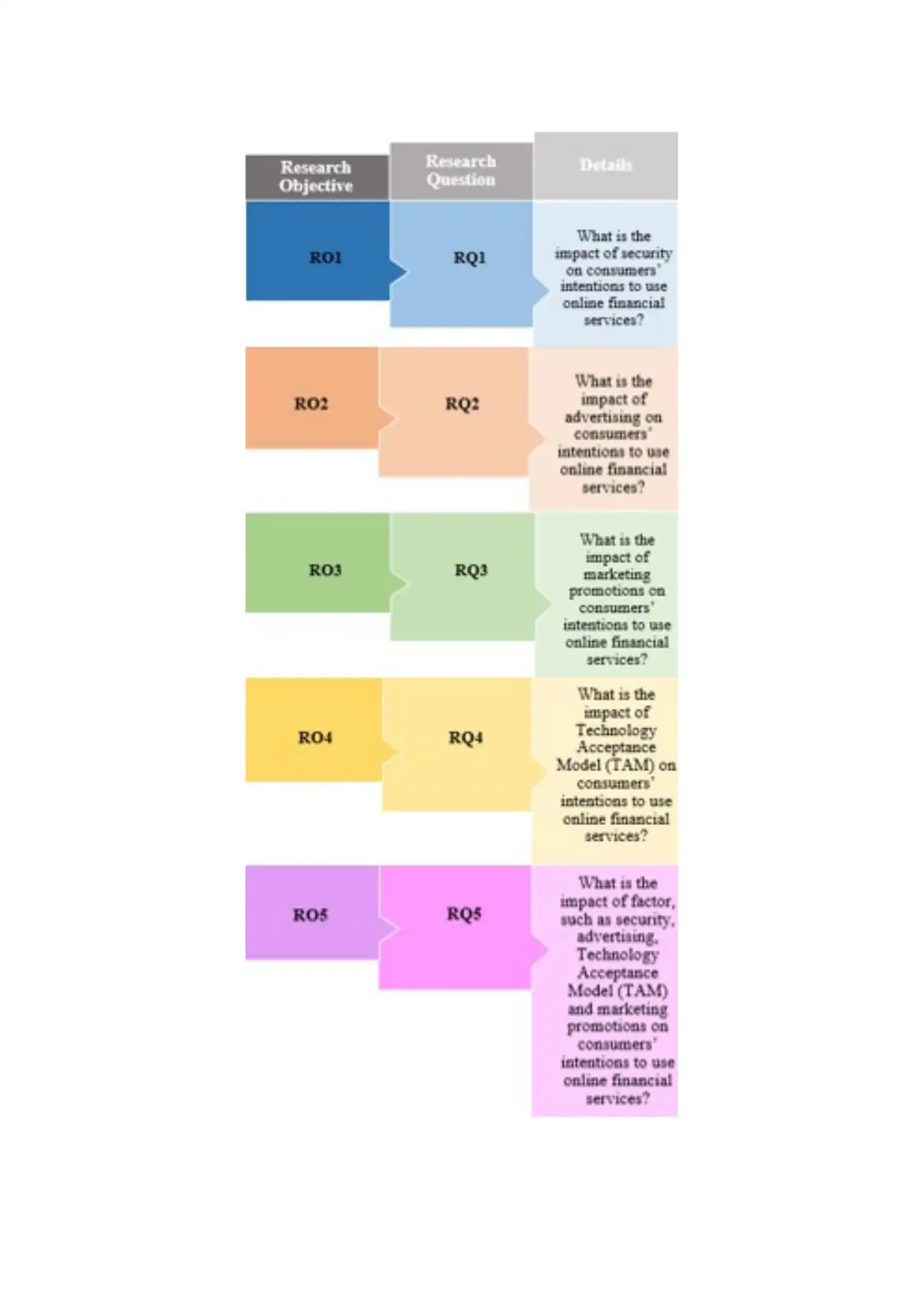
Paraphrase This Document
Need a fresh take? Get an instant paraphrase of this document with our AI Paraphraser
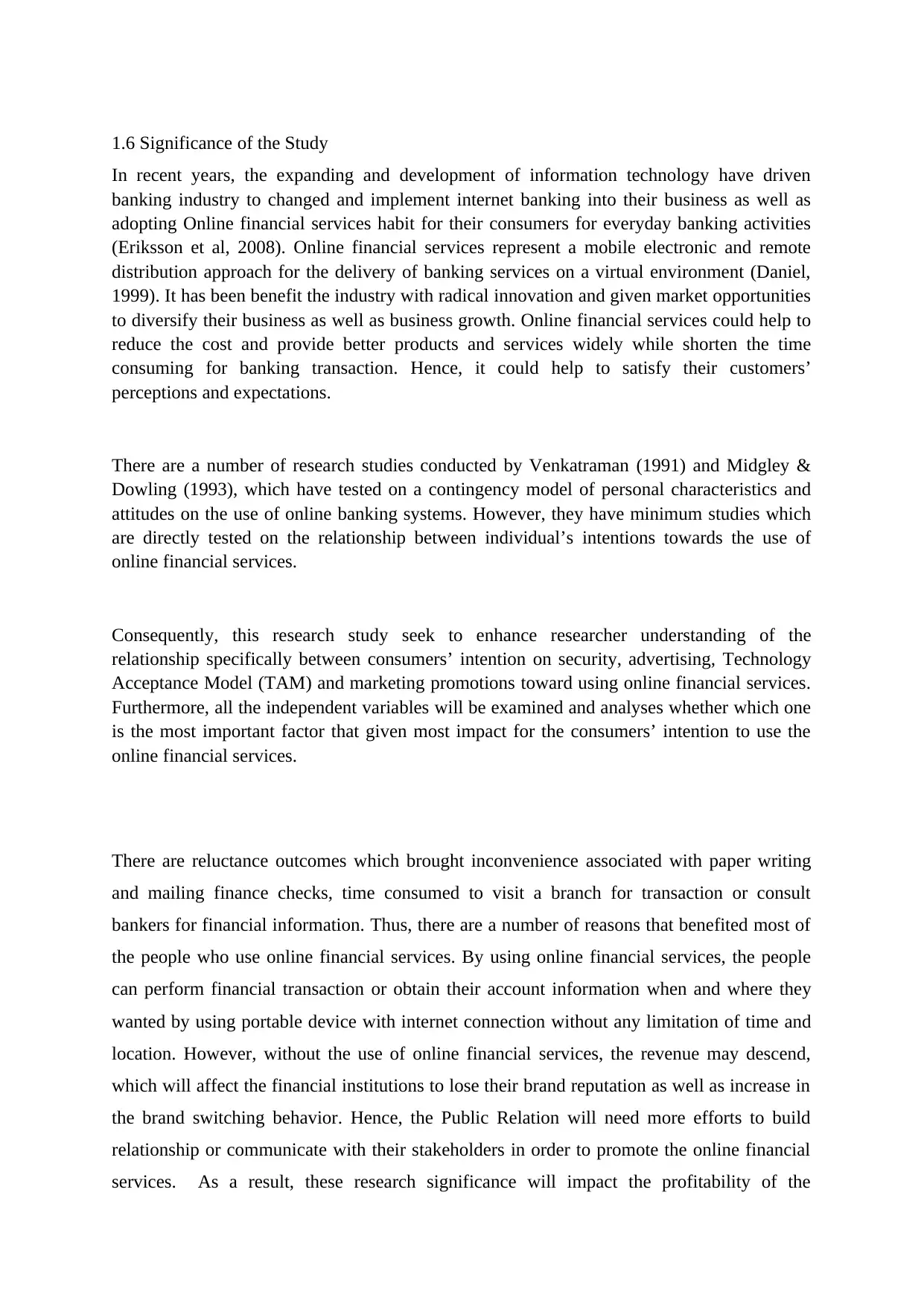
1.6 Significance of the Study
In recent years, the expanding and development of information technology have driven
banking industry to changed and implement internet banking into their business as well as
adopting Online financial services habit for their consumers for everyday banking activities
(Eriksson et al, 2008). Online financial services represent a mobile electronic and remote
distribution approach for the delivery of banking services on a virtual environment (Daniel,
1999). It has been benefit the industry with radical innovation and given market opportunities
to diversify their business as well as business growth. Online financial services could help to
reduce the cost and provide better products and services widely while shorten the time
consuming for banking transaction. Hence, it could help to satisfy their customers’
perceptions and expectations.
There are a number of research studies conducted by Venkatraman (1991) and Midgley &
Dowling (1993), which have tested on a contingency model of personal characteristics and
attitudes on the use of online banking systems. However, they have minimum studies which
are directly tested on the relationship between individual’s intentions towards the use of
online financial services.
Consequently, this research study seek to enhance researcher understanding of the
relationship specifically between consumers’ intention on security, advertising, Technology
Acceptance Model (TAM) and marketing promotions toward using online financial services.
Furthermore, all the independent variables will be examined and analyses whether which one
is the most important factor that given most impact for the consumers’ intention to use the
online financial services.
There are reluctance outcomes which brought inconvenience associated with paper writing
and mailing finance checks, time consumed to visit a branch for transaction or consult
bankers for financial information. Thus, there are a number of reasons that benefited most of
the people who use online financial services. By using online financial services, the people
can perform financial transaction or obtain their account information when and where they
wanted by using portable device with internet connection without any limitation of time and
location. However, without the use of online financial services, the revenue may descend,
which will affect the financial institutions to lose their brand reputation as well as increase in
the brand switching behavior. Hence, the Public Relation will need more efforts to build
relationship or communicate with their stakeholders in order to promote the online financial
services. As a result, these research significance will impact the profitability of the
In recent years, the expanding and development of information technology have driven
banking industry to changed and implement internet banking into their business as well as
adopting Online financial services habit for their consumers for everyday banking activities
(Eriksson et al, 2008). Online financial services represent a mobile electronic and remote
distribution approach for the delivery of banking services on a virtual environment (Daniel,
1999). It has been benefit the industry with radical innovation and given market opportunities
to diversify their business as well as business growth. Online financial services could help to
reduce the cost and provide better products and services widely while shorten the time
consuming for banking transaction. Hence, it could help to satisfy their customers’
perceptions and expectations.
There are a number of research studies conducted by Venkatraman (1991) and Midgley &
Dowling (1993), which have tested on a contingency model of personal characteristics and
attitudes on the use of online banking systems. However, they have minimum studies which
are directly tested on the relationship between individual’s intentions towards the use of
online financial services.
Consequently, this research study seek to enhance researcher understanding of the
relationship specifically between consumers’ intention on security, advertising, Technology
Acceptance Model (TAM) and marketing promotions toward using online financial services.
Furthermore, all the independent variables will be examined and analyses whether which one
is the most important factor that given most impact for the consumers’ intention to use the
online financial services.
There are reluctance outcomes which brought inconvenience associated with paper writing
and mailing finance checks, time consumed to visit a branch for transaction or consult
bankers for financial information. Thus, there are a number of reasons that benefited most of
the people who use online financial services. By using online financial services, the people
can perform financial transaction or obtain their account information when and where they
wanted by using portable device with internet connection without any limitation of time and
location. However, without the use of online financial services, the revenue may descend,
which will affect the financial institutions to lose their brand reputation as well as increase in
the brand switching behavior. Hence, the Public Relation will need more efforts to build
relationship or communicate with their stakeholders in order to promote the online financial
services. As a result, these research significance will impact the profitability of the
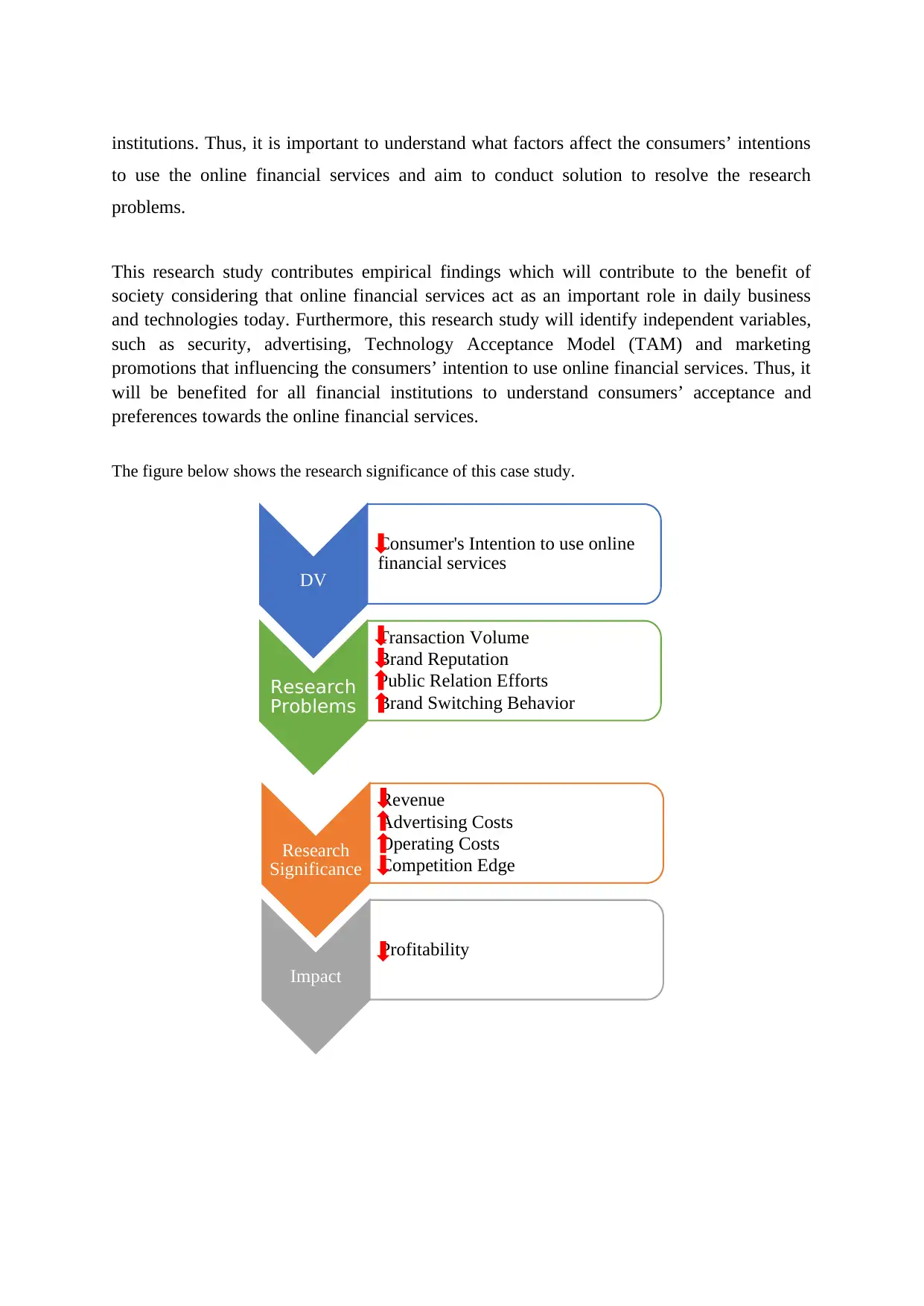
institutions. Thus, it is important to understand what factors affect the consumers’ intentions
to use the online financial services and aim to conduct solution to resolve the research
problems.
This research study contributes empirical findings which will contribute to the benefit of
society considering that online financial services act as an important role in daily business
and technologies today. Furthermore, this research study will identify independent variables,
such as security, advertising, Technology Acceptance Model (TAM) and marketing
promotions that influencing the consumers’ intention to use online financial services. Thus, it
will be benefited for all financial institutions to understand consumers’ acceptance and
preferences towards the online financial services.
The figure below shows the research significance of this case study.
DV
Consumer's Intention to use online
financial services
Research
Problems
Transaction Volume
Brand Reputation
Public Relation Efforts
Brand Switching Behavior
Research
Significance
Revenue
Advertising Costs
Operating Costs
Competition Edge
Impact
Profitability
to use the online financial services and aim to conduct solution to resolve the research
problems.
This research study contributes empirical findings which will contribute to the benefit of
society considering that online financial services act as an important role in daily business
and technologies today. Furthermore, this research study will identify independent variables,
such as security, advertising, Technology Acceptance Model (TAM) and marketing
promotions that influencing the consumers’ intention to use online financial services. Thus, it
will be benefited for all financial institutions to understand consumers’ acceptance and
preferences towards the online financial services.
The figure below shows the research significance of this case study.
DV
Consumer's Intention to use online
financial services
Research
Problems
Transaction Volume
Brand Reputation
Public Relation Efforts
Brand Switching Behavior
Research
Significance
Revenue
Advertising Costs
Operating Costs
Competition Edge
Impact
Profitability
⊘ This is a preview!⊘
Do you want full access?
Subscribe today to unlock all pages.

Trusted by 1+ million students worldwide
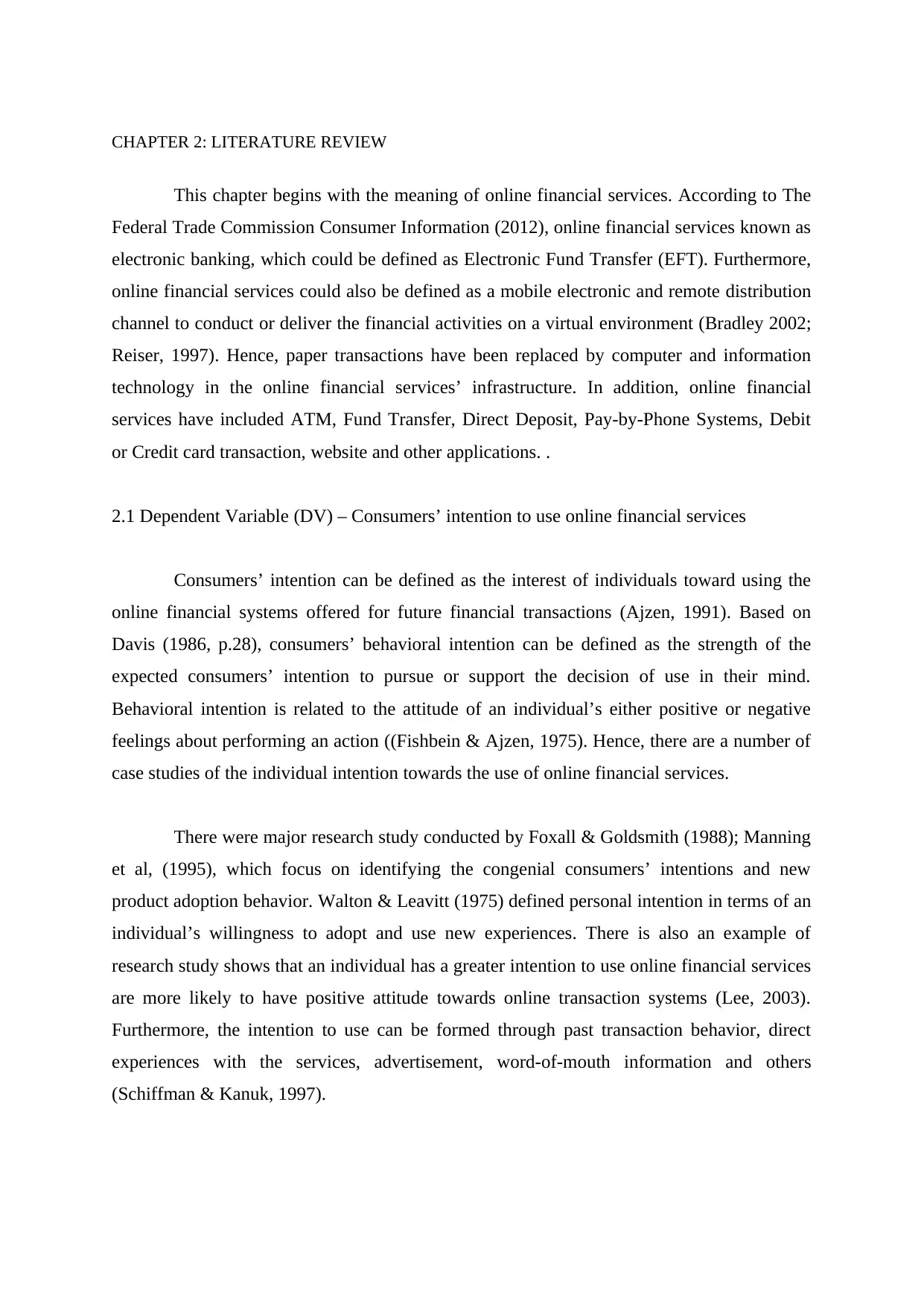
CHAPTER 2: LITERATURE REVIEW
This chapter begins with the meaning of online financial services. According to The
Federal Trade Commission Consumer Information (2012), online financial services known as
electronic banking, which could be defined as Electronic Fund Transfer (EFT). Furthermore,
online financial services could also be defined as a mobile electronic and remote distribution
channel to conduct or deliver the financial activities on a virtual environment (Bradley 2002;
Reiser, 1997). Hence, paper transactions have been replaced by computer and information
technology in the online financial services’ infrastructure. In addition, online financial
services have included ATM, Fund Transfer, Direct Deposit, Pay-by-Phone Systems, Debit
or Credit card transaction, website and other applications. .
2.1 Dependent Variable (DV) – Consumers’ intention to use online financial services
Consumers’ intention can be defined as the interest of individuals toward using the
online financial systems offered for future financial transactions (Ajzen, 1991). Based on
Davis (1986, p.28), consumers’ behavioral intention can be defined as the strength of the
expected consumers’ intention to pursue or support the decision of use in their mind.
Behavioral intention is related to the attitude of an individual’s either positive or negative
feelings about performing an action ((Fishbein & Ajzen, 1975). Hence, there are a number of
case studies of the individual intention towards the use of online financial services.
There were major research study conducted by Foxall & Goldsmith (1988); Manning
et al, (1995), which focus on identifying the congenial consumers’ intentions and new
product adoption behavior. Walton & Leavitt (1975) defined personal intention in terms of an
individual’s willingness to adopt and use new experiences. There is also an example of
research study shows that an individual has a greater intention to use online financial services
are more likely to have positive attitude towards online transaction systems (Lee, 2003).
Furthermore, the intention to use can be formed through past transaction behavior, direct
experiences with the services, advertisement, word-of-mouth information and others
(Schiffman & Kanuk, 1997).
This chapter begins with the meaning of online financial services. According to The
Federal Trade Commission Consumer Information (2012), online financial services known as
electronic banking, which could be defined as Electronic Fund Transfer (EFT). Furthermore,
online financial services could also be defined as a mobile electronic and remote distribution
channel to conduct or deliver the financial activities on a virtual environment (Bradley 2002;
Reiser, 1997). Hence, paper transactions have been replaced by computer and information
technology in the online financial services’ infrastructure. In addition, online financial
services have included ATM, Fund Transfer, Direct Deposit, Pay-by-Phone Systems, Debit
or Credit card transaction, website and other applications. .
2.1 Dependent Variable (DV) – Consumers’ intention to use online financial services
Consumers’ intention can be defined as the interest of individuals toward using the
online financial systems offered for future financial transactions (Ajzen, 1991). Based on
Davis (1986, p.28), consumers’ behavioral intention can be defined as the strength of the
expected consumers’ intention to pursue or support the decision of use in their mind.
Behavioral intention is related to the attitude of an individual’s either positive or negative
feelings about performing an action ((Fishbein & Ajzen, 1975). Hence, there are a number of
case studies of the individual intention towards the use of online financial services.
There were major research study conducted by Foxall & Goldsmith (1988); Manning
et al, (1995), which focus on identifying the congenial consumers’ intentions and new
product adoption behavior. Walton & Leavitt (1975) defined personal intention in terms of an
individual’s willingness to adopt and use new experiences. There is also an example of
research study shows that an individual has a greater intention to use online financial services
are more likely to have positive attitude towards online transaction systems (Lee, 2003).
Furthermore, the intention to use can be formed through past transaction behavior, direct
experiences with the services, advertisement, word-of-mouth information and others
(Schiffman & Kanuk, 1997).
Paraphrase This Document
Need a fresh take? Get an instant paraphrase of this document with our AI Paraphraser
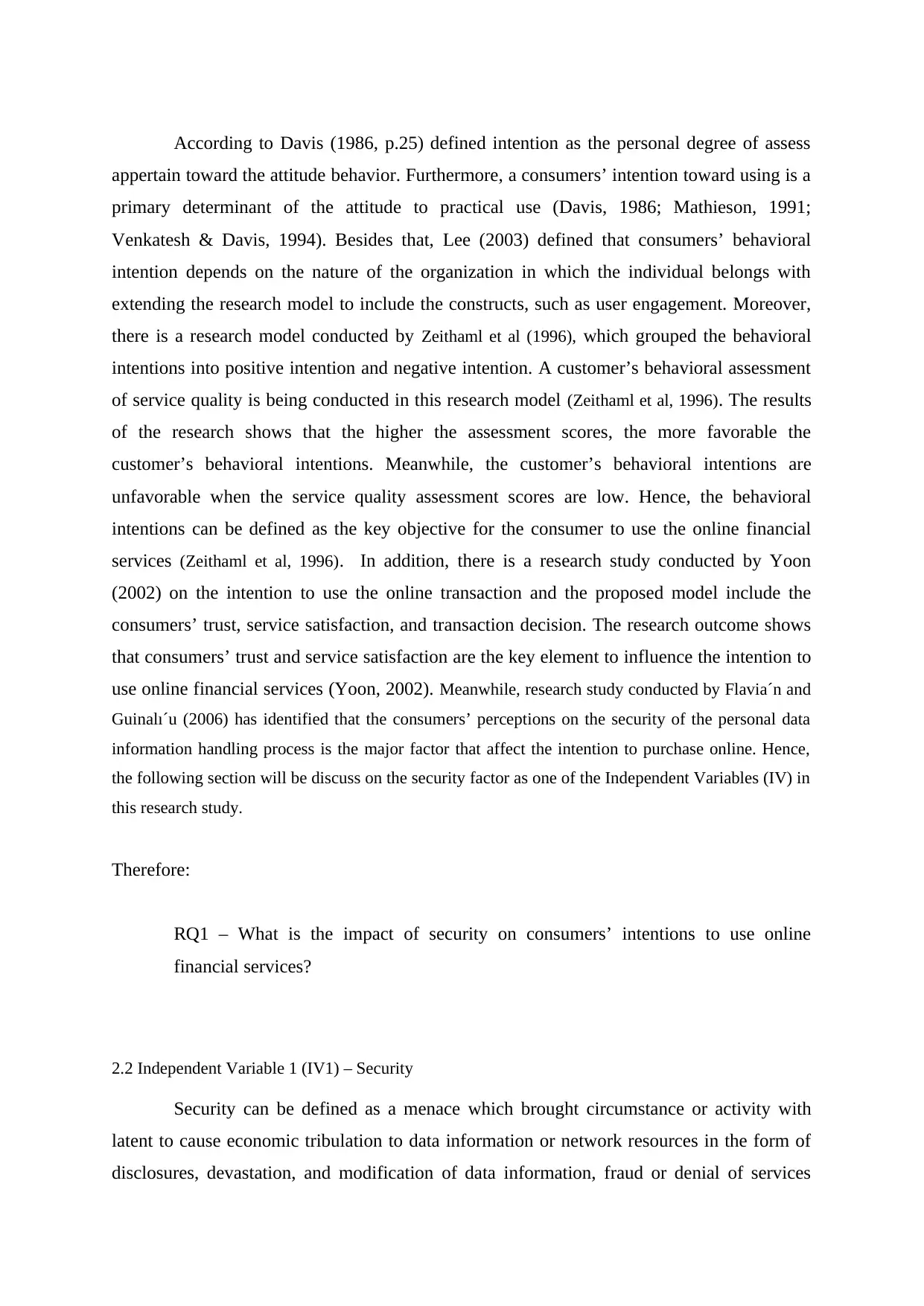
According to Davis (1986, p.25) defined intention as the personal degree of assess
appertain toward the attitude behavior. Furthermore, a consumers’ intention toward using is a
primary determinant of the attitude to practical use (Davis, 1986; Mathieson, 1991;
Venkatesh & Davis, 1994). Besides that, Lee (2003) defined that consumers’ behavioral
intention depends on the nature of the organization in which the individual belongs with
extending the research model to include the constructs, such as user engagement. Moreover,
there is a research model conducted by Zeithaml et al (1996), which grouped the behavioral
intentions into positive intention and negative intention. A customer’s behavioral assessment
of service quality is being conducted in this research model (Zeithaml et al, 1996). The results
of the research shows that the higher the assessment scores, the more favorable the
customer’s behavioral intentions. Meanwhile, the customer’s behavioral intentions are
unfavorable when the service quality assessment scores are low. Hence, the behavioral
intentions can be defined as the key objective for the consumer to use the online financial
services (Zeithaml et al, 1996). In addition, there is a research study conducted by Yoon
(2002) on the intention to use the online transaction and the proposed model include the
consumers’ trust, service satisfaction, and transaction decision. The research outcome shows
that consumers’ trust and service satisfaction are the key element to influence the intention to
use online financial services (Yoon, 2002). Meanwhile, research study conducted by Flavia´n and
Guinalı´u (2006) has identified that the consumers’ perceptions on the security of the personal data
information handling process is the major factor that affect the intention to purchase online. Hence,
the following section will be discuss on the security factor as one of the Independent Variables (IV) in
this research study.
Therefore:
RQ1 – What is the impact of security on consumers’ intentions to use online
financial services?
2.2 Independent Variable 1 (IV1) – Security
Security can be defined as a menace which brought circumstance or activity with
latent to cause economic tribulation to data information or network resources in the form of
disclosures, devastation, and modification of data information, fraud or denial of services
appertain toward the attitude behavior. Furthermore, a consumers’ intention toward using is a
primary determinant of the attitude to practical use (Davis, 1986; Mathieson, 1991;
Venkatesh & Davis, 1994). Besides that, Lee (2003) defined that consumers’ behavioral
intention depends on the nature of the organization in which the individual belongs with
extending the research model to include the constructs, such as user engagement. Moreover,
there is a research model conducted by Zeithaml et al (1996), which grouped the behavioral
intentions into positive intention and negative intention. A customer’s behavioral assessment
of service quality is being conducted in this research model (Zeithaml et al, 1996). The results
of the research shows that the higher the assessment scores, the more favorable the
customer’s behavioral intentions. Meanwhile, the customer’s behavioral intentions are
unfavorable when the service quality assessment scores are low. Hence, the behavioral
intentions can be defined as the key objective for the consumer to use the online financial
services (Zeithaml et al, 1996). In addition, there is a research study conducted by Yoon
(2002) on the intention to use the online transaction and the proposed model include the
consumers’ trust, service satisfaction, and transaction decision. The research outcome shows
that consumers’ trust and service satisfaction are the key element to influence the intention to
use online financial services (Yoon, 2002). Meanwhile, research study conducted by Flavia´n and
Guinalı´u (2006) has identified that the consumers’ perceptions on the security of the personal data
information handling process is the major factor that affect the intention to purchase online. Hence,
the following section will be discuss on the security factor as one of the Independent Variables (IV) in
this research study.
Therefore:
RQ1 – What is the impact of security on consumers’ intentions to use online
financial services?
2.2 Independent Variable 1 (IV1) – Security
Security can be defined as a menace which brought circumstance or activity with
latent to cause economic tribulation to data information or network resources in the form of
disclosures, devastation, and modification of data information, fraud or denial of services
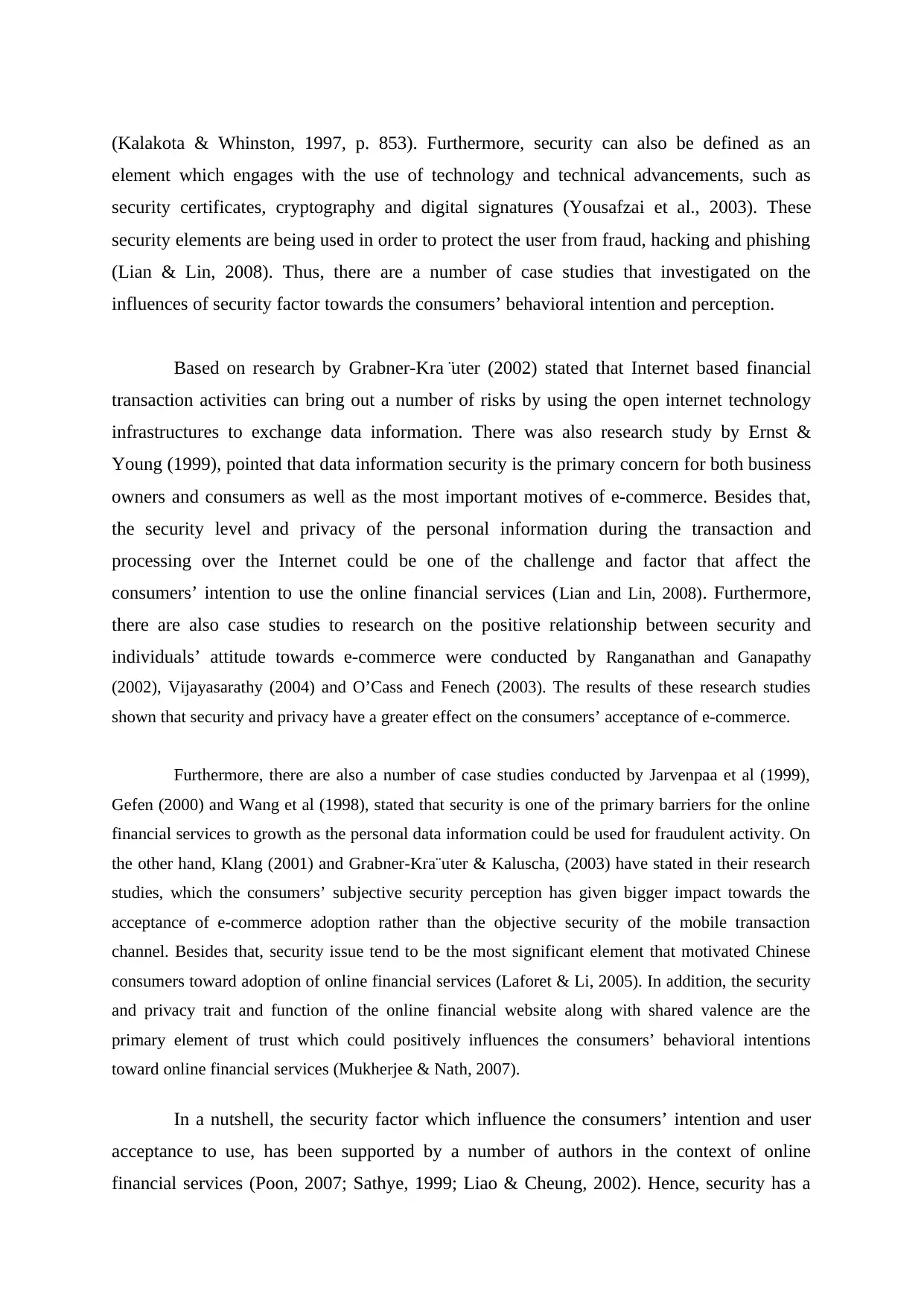
(Kalakota & Whinston, 1997, p. 853). Furthermore, security can also be defined as an
element which engages with the use of technology and technical advancements, such as
security certificates, cryptography and digital signatures (Yousafzai et al., 2003). These
security elements are being used in order to protect the user from fraud, hacking and phishing
(Lian & Lin, 2008). Thus, there are a number of case studies that investigated on the
influences of security factor towards the consumers’ behavioral intention and perception.
Based on research by Grabner-Kra ̈ uter (2002) stated that Internet based financial
transaction activities can bring out a number of risks by using the open internet technology
infrastructures to exchange data information. There was also research study by Ernst &
Young (1999), pointed that data information security is the primary concern for both business
owners and consumers as well as the most important motives of e-commerce. Besides that,
the security level and privacy of the personal information during the transaction and
processing over the Internet could be one of the challenge and factor that affect the
consumers’ intention to use the online financial services (Lian and Lin, 2008). Furthermore,
there are also case studies to research on the positive relationship between security and
individuals’ attitude towards e-commerce were conducted by Ranganathan and Ganapathy
(2002), Vijayasarathy (2004) and O’Cass and Fenech (2003). The results of these research studies
shown that security and privacy have a greater effect on the consumers’ acceptance of e-commerce.
Furthermore, there are also a number of case studies conducted by Jarvenpaa et al (1999),
Gefen (2000) and Wang et al (1998), stated that security is one of the primary barriers for the online
financial services to growth as the personal data information could be used for fraudulent activity. On
the other hand, Klang (2001) and Grabner-Kra¨uter & Kaluscha, (2003) have stated in their research
studies, which the consumers’ subjective security perception has given bigger impact towards the
acceptance of e-commerce adoption rather than the objective security of the mobile transaction
channel. Besides that, security issue tend to be the most significant element that motivated Chinese
consumers toward adoption of online financial services (Laforet & Li, 2005). In addition, the security
and privacy trait and function of the online financial website along with shared valence are the
primary element of trust which could positively influences the consumers’ behavioral intentions
toward online financial services (Mukherjee & Nath, 2007).
In a nutshell, the security factor which influence the consumers’ intention and user
acceptance to use, has been supported by a number of authors in the context of online
financial services (Poon, 2007; Sathye, 1999; Liao & Cheung, 2002). Hence, security has a
element which engages with the use of technology and technical advancements, such as
security certificates, cryptography and digital signatures (Yousafzai et al., 2003). These
security elements are being used in order to protect the user from fraud, hacking and phishing
(Lian & Lin, 2008). Thus, there are a number of case studies that investigated on the
influences of security factor towards the consumers’ behavioral intention and perception.
Based on research by Grabner-Kra ̈ uter (2002) stated that Internet based financial
transaction activities can bring out a number of risks by using the open internet technology
infrastructures to exchange data information. There was also research study by Ernst &
Young (1999), pointed that data information security is the primary concern for both business
owners and consumers as well as the most important motives of e-commerce. Besides that,
the security level and privacy of the personal information during the transaction and
processing over the Internet could be one of the challenge and factor that affect the
consumers’ intention to use the online financial services (Lian and Lin, 2008). Furthermore,
there are also case studies to research on the positive relationship between security and
individuals’ attitude towards e-commerce were conducted by Ranganathan and Ganapathy
(2002), Vijayasarathy (2004) and O’Cass and Fenech (2003). The results of these research studies
shown that security and privacy have a greater effect on the consumers’ acceptance of e-commerce.
Furthermore, there are also a number of case studies conducted by Jarvenpaa et al (1999),
Gefen (2000) and Wang et al (1998), stated that security is one of the primary barriers for the online
financial services to growth as the personal data information could be used for fraudulent activity. On
the other hand, Klang (2001) and Grabner-Kra¨uter & Kaluscha, (2003) have stated in their research
studies, which the consumers’ subjective security perception has given bigger impact towards the
acceptance of e-commerce adoption rather than the objective security of the mobile transaction
channel. Besides that, security issue tend to be the most significant element that motivated Chinese
consumers toward adoption of online financial services (Laforet & Li, 2005). In addition, the security
and privacy trait and function of the online financial website along with shared valence are the
primary element of trust which could positively influences the consumers’ behavioral intentions
toward online financial services (Mukherjee & Nath, 2007).
In a nutshell, the security factor which influence the consumers’ intention and user
acceptance to use, has been supported by a number of authors in the context of online
financial services (Poon, 2007; Sathye, 1999; Liao & Cheung, 2002). Hence, security has a
⊘ This is a preview!⊘
Do you want full access?
Subscribe today to unlock all pages.

Trusted by 1+ million students worldwide
1 out of 22
Related Documents
Your All-in-One AI-Powered Toolkit for Academic Success.
+13062052269
info@desklib.com
Available 24*7 on WhatsApp / Email
![[object Object]](/_next/static/media/star-bottom.7253800d.svg)
Unlock your academic potential
Copyright © 2020–2025 A2Z Services. All Rights Reserved. Developed and managed by ZUCOL.




